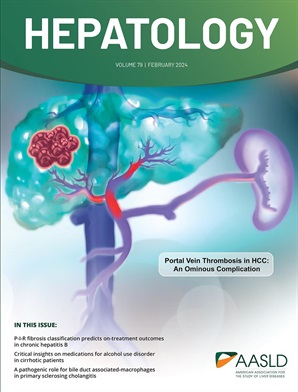丙型肝炎病毒超变异区 1 插入物的流行及其在抗体逃避中的作用
IF 12.9
1区 医学
Q1 GASTROENTEROLOGY & HEPATOLOGY
引用次数: 0
摘要
背景和目的:全球约有 5000 万人感染慢性丙型肝炎病毒 (HCV),每年造成约 25 万人死亡。有效的疫苗需要克服病毒的高度多样性和 HCV 规避中和抗体(NAbs)的能力。包膜蛋白 E2(名为超变异区 1 (HVR1))N 端基团的快速抗原漂移是通过一种尚不完全清楚的涉及病毒进入因子的机制逃避 NAb 的关键因素。HVR1的标准长度为27个氨基酸,但在感染基因型1b的患者中出现了2-4个氨基酸的插入。我们的目的是确定 HVR1 插入是否会因 HVR1 的极端变异而被低报。方法和结果:我们在常规 NGS 患者等位组中观察到了 0.7% 的 HVR1 插入率。因此,我们对 131 名 HCV 感染者的 E1E2 序列进行了直接序列分析。有趣的是,我们观察到 3% 的患者携带有显性 HVR1 插入的病毒(基因型 1a、2b、3a)。在 HCV 细胞培养重组体中插入较长的非规范 HVR1 经常会导致适存性丧失。然而,具有 HVR1 插入的培养病毒在体内完全存活。有趣的是,在插入 HVR1 的适应基因型 1b 重组子中,我们发现了内部 HVR1 缺失,这增加了抗体敏感性,令人惊讶的是,这与 LDLr 依赖性的降低而非 SR-BI 依赖性的降低更相关,表明 LDLr 在逃避 NAb 方面的作用。相反,HVR1 插入对受体依赖性没有影响,但却调节了表位特异性 NAb 敏感性。结论HVR1插入的普遍性和对NAb敏感性的调节表明,它们代表了HCV在感染过程中逃避新出现的NAb的一种机制。本文章由计算机程序翻译,如有差异,请以英文原文为准。
Prevalence of hepatitis C virus hypervariable region 1 insertions and their role in antibody evasion
Background and Aims: Chronic hepatitis C virus (HCV) infection afflicts around 50 million people globally, causing ~250,000 deaths yearly. An effective vaccine needs to overcome high viral diversity and HCV’s ability to evade neutralizing antibodies (NAbs). Rapid antigenic drift in the N-terminal motif of envelope protein E2, named hypervariable region 1 (HVR1), is critically involved in NAb evasion via an incompletely understood mechanism involving viral entry factors. The canonical length of HVR1 is 27 amino acids, but insertions of 2-4 amino acids was described in patients infected with genotype 1b. We aimed at determining whether HVR1 insertions may be underreported due to extreme HVR1 variability. Approach and Results: We observed a 0.7% HVR1 insertion prevalence in routine NGS patient contigs. Thus, we performed direct sequence analysis of E1E2 sequences from 131 HCV infected patients. Interestingly, we observed that 3% of patients harbored viruses (genotype 1a, 2b, 3a) with dominant HVR1 insertions. Insertion of longer non-canonical HVR1s into HCV cell culture recombinants frequently caused loss of fitness. However, culture-viable viruses with HVR1 insertions were fully viable in vivo . Interestingly, in adapted genotype 1b recombinants with HVR1 insertions, we found internal HVR1 deletions, that increased antibody sensitivity, which surprisingly correlated more with reduced LDLr than reduced SR-BI dependency, indicating a role of LDLr in NAb evasion. Conversely, HVR1 insertions had no effect on receptor dependency, however, they modulated epitope-specific NAb sensitivity. Conclusions: HVR1 insertion prevalence and NAb sensitivity modulation indicate they represent a mechanism by which HCV evades emerging NAbs during infection.
求助全文
通过发布文献求助,成功后即可免费获取论文全文。
去求助
来源期刊

Hepatology
医学-胃肠肝病学
CiteScore
27.50
自引率
3.70%
发文量
609
审稿时长
1 months
期刊介绍:
HEPATOLOGY is recognized as the leading publication in the field of liver disease. It features original, peer-reviewed articles covering various aspects of liver structure, function, and disease. The journal's distinguished Editorial Board carefully selects the best articles each month, focusing on topics including immunology, chronic hepatitis, viral hepatitis, cirrhosis, genetic and metabolic liver diseases, liver cancer, and drug metabolism.
 求助内容:
求助内容: 应助结果提醒方式:
应助结果提醒方式:


